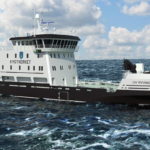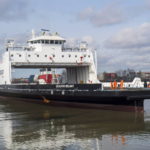Hybrid is one of today’s buzzwords. Cutting emissions and fuel costs by using battery power becomes increasingly attractive as the technology matures. Projects in the ferry, offshore and cargo segments prove it is feasible
Batteries as a source of emission free propulsion or auxiliary power are not only discussed for use in cars. Cost[ds_preview], size and low power density have long been – and still are – hurdles, but the pace of innovation is picking up. Battery-hybrid vessels are already in service, e.g. in Norway, and ferry operator Scandlines bets on the technology for its large ferries despite the difficulties (HANSA 12/2015).
Now the maritime world is eagerly awaiting the start of construction of two new vessels at Kleven shipyard in Norway. »Roald Amundsen« and »Fridtjof Nansen« will not just be another two expedition cruisers. Designed by Rolls-Royce, the arctic exploration cruise ships might get the role of trailblazers for the way, large vessels will be propelled in the future. In their effort to become a leading provider of integrated vessel designs, Rolls-Royce have taken a big step with the Hurtigruten vessels. The ships – 140m long, 23,6m wide, 5,3m draught, 20,889 gt – will use a new and environmentally sustainable hybrid technology that will enable significant savings in fuel consumption and emissions. Another novelty will be fully electric propulsion on ships of that size.
The hybrid technology for the Hurtigruten vessels will be delivered in two phases: On »Roald Amundsen«, scheduled for delivery in 2018, auxiliary battery power will be used for »peak shaving«, providing reductions in fuel consumption. The engines can be operated in their optimal performance range while the batteries can jump in to take peak loads. On the second vessel, »Fridtjof Nansen«, Hurtigruten aims to install larger batteries that enable fully electric sailing over longer distances and longer periods of time. This will be used when sailing into fjords, at port and in vulnerable areas allowing silent and emission free sailing. Vessel number two is scheduled for delivery from Kleven in 2019. Hurtigruten also intends to refurbish »Roald Amundsen«.
»There is still discussion about the size of the batteries, also about which technology will be finally deployed,« John Roger Nesje Vice President, Power Electric Systems, Rolls-Royce, tells HANSA. Battery technology evolves at a rapid pace, today’s state of the art can easily become old hat over the course of a year. It is also not clear, yet, by how much the battery package of the second vessel will be increased. »That is all part of the engineering process, battery rooms and fire extinguishing systems have to be engineered and permits have to be obtained,« Nesje says.
The key to efficiency
On »Roald Amundsen« the batteries will mainly be charged by the ship’s main engines. »On the first Hurtigruten vessel, during peak shaving, no deep discharging will happen, the batteries will be in stand-by mode to take peak loads and make the main engines more efficient,« Nesje explains. In addition to the hybrid power solution, the vessels will have the latest automation and control systems, including the Rolls-Royce Unified Bridge, the first delivery of two azipull propellers using permanent magnet technology, two large tunnel thrusters, stabilisers, four Bergen B33:45 engines, winches and power electric systems. Hybrid technology, in combination with the construction of the hull and effective use of electricity on board, will reduce the fuel consumption by approximately 20% and CO2 emissions by 20% (>3,000t/year).
A key to the efficiency of the design is the high level of integration. Rolls-Royce in this regard is in an advantageous position of being in control all of the »big products«: High speed and medium speed engines, power distribution, electric frequency conversion propulsion, winches, vessel design. »Not many others have that kind of overview, it gives us a chance to be clever,« Nesje says. »Hybrid systems are highly complex, so customers benefit from taking most components from one supplier.«
The two 140m Hurtigruten hybrid vessels stand out because of their size – but for how long? Color Line has already awarded Ulstein Verft a contract for the construction of »the largest hybrid vessel of the world«. The 160m ferry with a capacity of 2,000 passengers and 500 cars is planned to enter service in summer 2019. The ferry is a plug-in hybrid, where the batteries are recharged via a power cable with green electricity from their own shore facilities or recharged on board by the ship›s generators. The ship will have full battery power into and out of the fjord.
If the battery-hybrid solutions on these ships prove to work, more and more shipowners are likely to become interested in the technology. »Full battery propulsion is limited by physical constraints,« Nesje says. »The power density in batteries is far away from that of fossil fuels, so you naturally have a storage problem on long distances. Of course you can out bigger battery packs on cruise and RoPax vessels.« But for now, Nesje wants to turn the focus away from vessels sailing on batteries alone: »Batteries can do so much more, like peak shaving or for spinning reserve or smoothing of engine operations.« The company has already equipped several big cruise vessels with energy storage for tasks such as steering backup.
The passenger shipping market seems currently to be the main driver for the hybrid »movement«. Besides smaller ferries and sightseeing vessels, there are quite a few bigger projects that recently have been commissioned or that have just started. Earlier this year, Canadian operator Seaspan Ferries Corporation (SFC) welcomed two new, dual-fuelled/hybrid (LNG, diesel and battery) vessels to its fleet. »Seaspan Swift« and »Seaspan Reliant«, the first eco-ferries of their kind in North America, were designed by Vard Marine and constructed at Sedef Shipyard in Istanbul, Turkey. The 148.9m ferries can accommodate up to 59 trailers of 53’. The vessels are powered by two Wärtsilä 34DF dual-fuel engines and a 1050VDC, 546 kWh energy storage system consisting of 84 lithium polymer batteries supplied by Corvus Energy that will serve as spinning reserve and power for responsive harbour manoeuvring.
Robotic shore-side connection
In the USA, All American Marine (AAM) recently was awarded a contract for the construction of a new hybrid electric passenger vessel. The 600-passenger ship for the Red and White Fleet of San Francisco is scheduled for delivery in 2018. The ship will feature BAE Systems’ HybriDrive propulsion system and two 80 kWh Corvus Energy lithium-ion battery packs.
The HH Ferries Group/Scandlines currently modernizes »Tycho Brahe« and »Aurora« for fully electric propulsion. Upon completion the 111m long 12,000 gt ferries will be the world’s largest emission-free electric ferries. ABB supplies the complete 4 MW power and propulsion systems including batteries, energy storage control system and Onboard DC Grid technology. At both ends of the route ABB will supply the first automated shore-side charging stations using an industrial robot, to optimize the connection time.
In September last year, the Norwegian Coastal Administration’s (NCA) has named the »Bøkfjord«. This new multifunction vessel combines battery power with diesel propulsion. The vessel is equipped with a 850 kWh battery pack in addition to a traditional propulsion system comprising three diesel-powered electrical generators. The battery allows the operators to shut down one engine during work and have only one running with the battery pack used to cover occasional peak loads. When at shore, the diesel engines can be shut down and power can be drawn from the batteries that can also be recharged from an onshore power supply.
Rolls-Royce just announced that the second ship for the NCA, multipurpose vessel »Ryvingen«, will combine diesel power with a 2,000 kWh battery.
Another highly anticipated project is the UK’s new polar research vessel, »Sir David Attenborough«. The Rolls-Royce designed ship is being built at Cammell Laird’s shipyard in England and will include electrical systems with 5 MW peak effect battery. The diesel-electric propulsion system will include four Bergen B33:45 engines and Saft li-ion batteries with 1,450 kWh. Battery power will be used for DP, ice navigation boost and lowering noise levels during research works.
The offshore sector is another interesting market. Rolls-Royce has been proving battery technology with a UT 776 CDG Offshore vessel since the summer of 2015. »There are a lot of initiatives coming from the offshore sector such as container-based retrofits to enable DP operation on one engine. That will be a step change in offshore operation,« Nesje says and adds, »This is happening now, despite the downturn in the offshore market. Shipowners are chasing contracts. To be picked they have to offer the best vessels.«
From ferries and specialized vessels, the hybrid technology is also making its way to the cargo ship market. In January, Norwegian shipowner Stenersen announced the order of two new 17,500 dwt chemical tankers that will feature a hybrid electric propulsion system. Built by Taizhou Kouan Shipbuilding, China, Corvus Energy will supply its Orca Energy lithium-ion batteries for energy storage. The power to charge the batteries will be generated by WE Tech direct drive permanent magnet shaft generator. There are also options for two more vessels of this type. With the batteries, in maneuvering one auxiliary engine can be shut down. In port the auxiliary and the battery can replace the main engine.
More potential for cargo ships
Fully electric cargo vessels are not in sight, yet, but there are many areas of application in the cargo sector: safety backup for redundancy, loading cargo, crane operation, pumps, winches etc. Rolls-Royce also works on study concepts for containerized energy storage for container vessels. Installed in conventional cargo boxes, discharged batteries can be exchanged during a port stay.
For batteries as pure propulsion power source shortsea trade could be a good development task, Nesje thinks. Vessels could sail on batteries or at least use battery power to go in and out of ports to reduced emissions in certain areas or fulfil certain emissions requirements. »Rules and regulations in harbour and city areas or emissions taxes might give us a positive business case in the future. But the challenge will be the big ones, sailing from Singapore to Hamburg. This will not happen in my lifetime,« Nesje says.
Felix Selzer






















